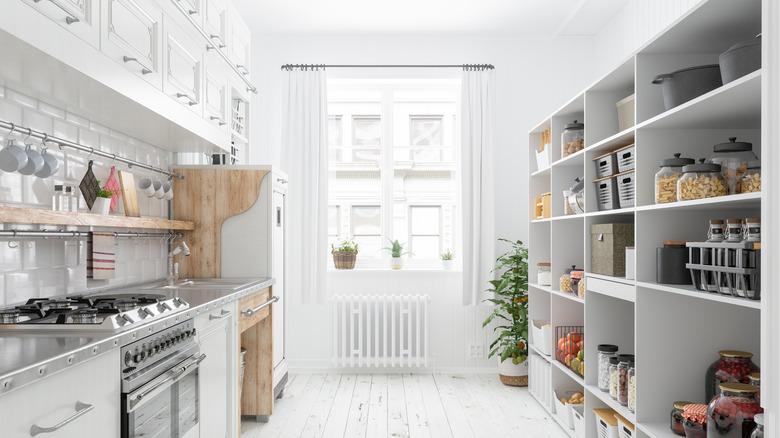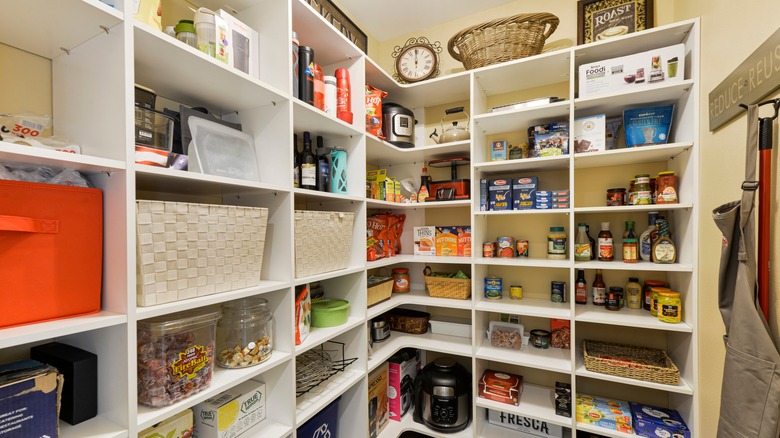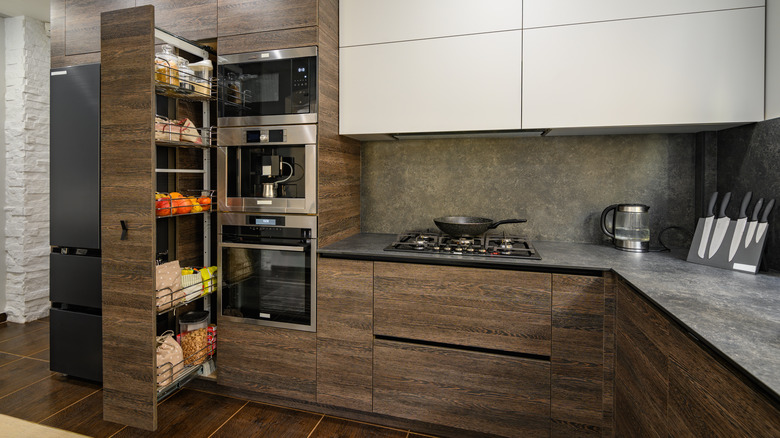Walk-In Vs. Cabinet Pantry: Which One Actually Makes Sense In Your Home?
The concept of a traditional kitchen has been evolving, with several homeowners remodeling their kitchens as areas for socialization and entertainment. Unsurprisingly, there's been a rise in the search for walk-in kitchen pantries. In fact, according to the 2023 Houzz U.S. Emerging Summer Trends Report, there's been a 2,636% rise. While the additional storage offered by walk-in pantries helps declutter the kitchen counter and opens up the space for social interactions, cabinet pantries remain popular as they're relatively economical and offer more flexibility. So before you set about choosing the right kitchen pantry for your home, it's necessary to consider their pros and cons, as well as your budget and personal preferences.
Walk-in pantries typically involve wall-to-wall shelves housed in a separate room adjoining the kitchen, whereas cabinet pantries entail freestanding cabinets that are installed right into the kitchen. While walk-in pantries provide superior storage options, they come at a higher cost. Conversely, cabinet pantries offer convenience and accessibility, making it easier to access kitchen essentials without traversing between rooms.
Walk-in pantries
Walk-in pantries come out on top in terms of storage space, making them ideal for bulk buyers. Floor-to-ceiling, tall shelves allow for creative organization, with multiple columns particularly dedicated to key items. For instance, separate shelves can be apportioned to food ingredients, pots, cookbooks, and even wine bottles. Major kitchen appliances, such as coffee machines, toasters, and microwaves, can also be stored on the walk-in's taller shelves. Moreover, distinct spaces can be allocated to store linen, extending the walk-in's role beyond the kitchen. All in all, walk-in pantries can look very aesthetic if they're well-organized and clutter-free.
However, such ample storage isn't cheap. On average, a walk-in pantry can cost upward of $2,000 compared to a more comfortable $325 to $1,200 range for a cabinet pantry. Besides, while walk-in pantries help clear up counter space, they're also inconvenient, as you might need to make multiple trips to the pantry during cooking. Moreover, if you can't spare much time for cleaning, a walk-in may be unsuitable as its open shelves require high maintenance.
Cabinet pantries
While cabinet pantries may not offer as much space, they have walk-in kitchen pantries beat in terms of flexibility and versatility. These cabinets allow for additional custom integrations, such as rollout and door shelves, which magnify the storage availability. They also offer improved accessibility, enabling the grabbing of multiple items at one go in sharp contrast to walk-in pantries that necessitate several trips. Further, being only 2-3 feet wide, cabinet pantries take up relatively less square footage, making them an ideal choice if you're facing space constraints.
Though cabinet pantries provide easy convenience by centralizing all the kitchen essentials in one space, this ease comes at the sacrifice of much-needed counter space. What's more, some cabinet pantries may not be optimal for storing large appliances even after retrofitting, as the additional shelves may offer more vertical than horizontal capacity. Moreover, even though cabinet pantries are priced lower than walk-ins, inserting more features will drive up the installation costs significantly.


